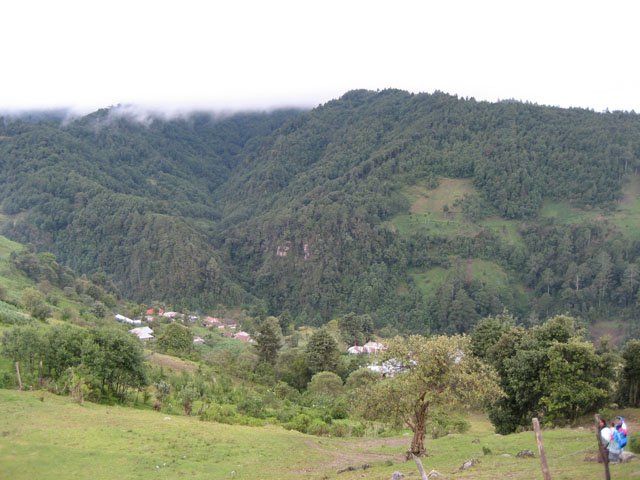
Temux Grande, our new Guatemala home.
Hello once again.
The last entry was specifically tailored to amuse my architect and contractor buddies. This one is more leaning towards my friends that are doctors or are in med school. In addition, we’ll talk some about the amazing goings-on surrounding our new hometown, Temux Grande.
- Creepy Crawlies (Insects, parasites, and infectious skin diseases to amuse my doctor friends)
- Random health stuff
- Santa Eulalia & counterpart day
- Temux Grande– first visit
- Doña Suzanna’s Stove
- Garbage
- Intellectual property
Creepy Crawlies
As you may know, we have ongoing training every week from the Peace Corps medical staff. This week, we discussed (in depth) all sorts of gross skin ailments that are available here in Guatemala. The statistics are unsettling, from the relatively mild “30% of you will get lice during your service” to the disconcerting “10% of you will contract scabies”. Other problems here include bedbugs (kindof like mosquitoes, but don’t fly and live in your mattress), body & head lice, chagas bug, something called a blister beetle (don’t touch it, or its excretions cause massive watery blisters), fleas, and the brown recluse spider. In an attempt to lighten the mood, the medical officer brought plush toy versions of many of these critters. They were really cool, and are available from GiantMicrobes.com. Check em out! I was feeling itchy for the rest of the day. Also, I have personal stories for the last two.
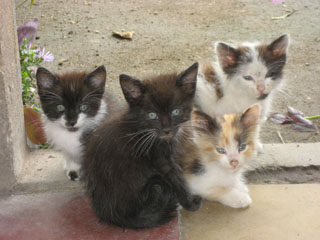 Last week, i was playing with the rather cute kittens that are new to our house. The kids love them, but Froilan (the grandfather) dislikes them. He had told me a few times before that I should not leave my door open, or they might come in and leave pulgas on my bed. I was kindof confused as to why they would eave “thumbs” on my bed, and assumed that he meant footprints. I had a cat when i was a kid, and their footprints that appeared on every flat surface never really bothered me much, so I immediately forgot the conversation. Later that evening, however, I was playing with the calico kitten on my lap, and happened to notice a half dozen fleas crawling all over its face. YAAAAHHH!!!! A quick flip through the dictionary revealed that “thumb” is actually pulgar, and pulgas is FLEAS. I guess I still need to work on my Spanish.
Last week, i was playing with the rather cute kittens that are new to our house. The kids love them, but Froilan (the grandfather) dislikes them. He had told me a few times before that I should not leave my door open, or they might come in and leave pulgas on my bed. I was kindof confused as to why they would eave “thumbs” on my bed, and assumed that he meant footprints. I had a cat when i was a kid, and their footprints that appeared on every flat surface never really bothered me much, so I immediately forgot the conversation. Later that evening, however, I was playing with the calico kitten on my lap, and happened to notice a half dozen fleas crawling all over its face. YAAAAHHH!!!! A quick flip through the dictionary revealed that “thumb” is actually pulgar, and pulgas is FLEAS. I guess I still need to work on my Spanish.
A few days earlier, I was getting dressed for a meeting with our associates at the Ministry of Health. I took my dress jacket from the hook on the wall, put it on, and looked down to find a big hairy spider about the size of a silver dollar on my chest. Emily and I both gasped, and chased it around my body for a while, until it fell off onto the floor. I shooed it out the door with my foot. In the Creepy Crawly seminar, i discovered that this had been a Brown Recluse spider, a common poisonous arachnid in these parts. They are pretty aggressive, and their bite causes pain and swelling at the least, and occasionally leads to necropsy and hemhorraging reaction that includes bleeding from the gums and mucous membranes.
Random Health Stuff
Health topics have cropped up a lot this month. In the Health Center i was working in, I noticed a lot of advertisements for the government sponsored vaccination program for children, one element of which includes giving Vitamin A drops to children under 5. I am told this is because Guatemalans as a culture don’t eat leafy green vegetables, and this vitamin is difficult to get any other way.
Elsewhere I have been overwhelmed by how BAD the dental care is around here. Have you ever seen those fake hillbilly teeth that kids get out of bubble gum machines? Much of the rural population here is WAY worse than that… i wish i could get a picture of some of these examples, but there is no way to get it without being offensive. I am talking about swollen gums with one or two teeth sticking out at odd angles, dark yellow and pitted with decay, parts cracked off, the inner germ showing. It’s painful to look at, and it’s EVERYWHERE, even in kids with baby teeth. And why? Because Guatemalans put enormous amounts of sugar in everything. Three spoons in a cup of coffee, oatmeal as sweet as ice cream, spoons of sugar in a baby’s bottle. Add to that the scarcity of toothbrushes, and you get a pretty gross mess.
But, the government doesn’t totally ignore the problem; it uses it as a solution to a different problem. In much the same way that salt in the US comes with iodine in it to prevent goiter in the populace, there is a law here that says ALL sugar sold in Guatemala must be fortified with Vitamin A. What?
Santa Eulalia & counterpart day
The day finally came and we were assigned our site for the next 2 years. Santa Eulalia has the following interesting facts:
- It’s in the department (kindof like a state) of Huehuetenango, pronounced “WAY-way tuh-NANG-o”
- It’s about 2800 meters above sea level, about 2 miles up.
- It’s cold, and occasionally gets snow (a big deal here in Central America)
- Has a population of about 6,000 people in town, and a total of 40,000 in the municipal region
- Everyone speaks the Mayan dialect Q’anjob’al, except us and the doctor
- Has three Health Posts (more on that later)
- Has the highest maternal mortality rate per capita in the country
- Has the second highest infant mortality rate in the country
- 99% of births are in the home
- Emily thinks the name is lucky, because Santa Eulalia is the patron saint of Barcelona.
Getting to Santa Eulalia is pretty tough. From the Peace Corps HQ, it’s about 5 hours in bus to the capitol of Huehuetenango, then we switch to a microbus for another 4 hours of twisting mountain roads. After that, we ride in the back of a pickup to get to the aldea of Temux Grande (more on that later). This trip can only be done in one arduous day if it’s very carefully planned out in advance. Anything goes wrong with the sporadic and unreliable bus departures, and you get to spend a bonus night in a hostel somewhere.
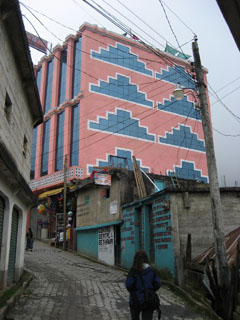 Once you get there, though, it’s quite pretty. The town itself is quaint, built right on the top of a mountain with staircase-steep streets and dizzying views. Clouds roll through the streets between buildings as they make their way across the mountain range. The people are generally friendly, and most stop and stare or say hello or remark on our presence in some way, as we are the ONLY whiteys in town. There are a few small stores, none of which sell liquid milk. It’s powdered milk or nothing. After asking at the first few stores, we were thereafter greeted with “we only have powdered” as word of our quest seemed to spread faster than we walk. They also have the ugliest building I have ever seen, an expensive hotel near the top of the town (see picture). And by expensive, i mean $15 per night for a double: twice the allowance Peace Crops gave us.
Once you get there, though, it’s quite pretty. The town itself is quaint, built right on the top of a mountain with staircase-steep streets and dizzying views. Clouds roll through the streets between buildings as they make their way across the mountain range. The people are generally friendly, and most stop and stare or say hello or remark on our presence in some way, as we are the ONLY whiteys in town. There are a few small stores, none of which sell liquid milk. It’s powdered milk or nothing. After asking at the first few stores, we were thereafter greeted with “we only have powdered” as word of our quest seemed to spread faster than we walk. They also have the ugliest building I have ever seen, an expensive hotel near the top of the town (see picture). And by expensive, i mean $15 per night for a double: twice the allowance Peace Crops gave us.
For much of our job here, we will be working centered around the health centers. The municipality of Santa Eulalia has three of them:
- Santa Eulalia (in town)
- Temux Grande (a small aldea in the country)
- Quixabaj (a remote country outpost)
The doctor spends his time in the main post in Santa Eulalia, and the other two are run by nurses and the doctor visits once every 2 months. When I asked him what happens when someone in Temux gets really sick, he responded with se muere (they die). He did not smile jokingly when he said this.
Another issue for us is where we are going to actually live. We couldn’t get a clear answer on this, except for a vague mention that we would be living in the Health Post. We dismissed this option, thinking there was a misunderstanding. We are supposed to WORK in the Health Post, not live there… The second day, the doctor and the health tech took us to Temux Grande, to tour the facility there. Then things got interesting.
Temux Grande
After the winding 40 min ride through serpentine roads, we came to Temux Grande. It’s a tiny little village way out in the green mountains. When we exited the microbus, we were met by a handful of town elders and taken on a tour of their new health center. They were quite proud of it, and rightfully so: it was clean, new (built 2007!), five times the size of any other health center I’ve yet seen, and well equipped with modern sewage system, running water, a shower, a kitchen, several exam rooms, and an apartment… things said earlier were starting to make more sense. At that moment I was interrupted by an explosion outside that caused me to nearly jump out of my shorts. “What was that?” i asked, and they all laughed. One of the elders with Spanish replied, “Fireworks. They are for you, because you are here.”
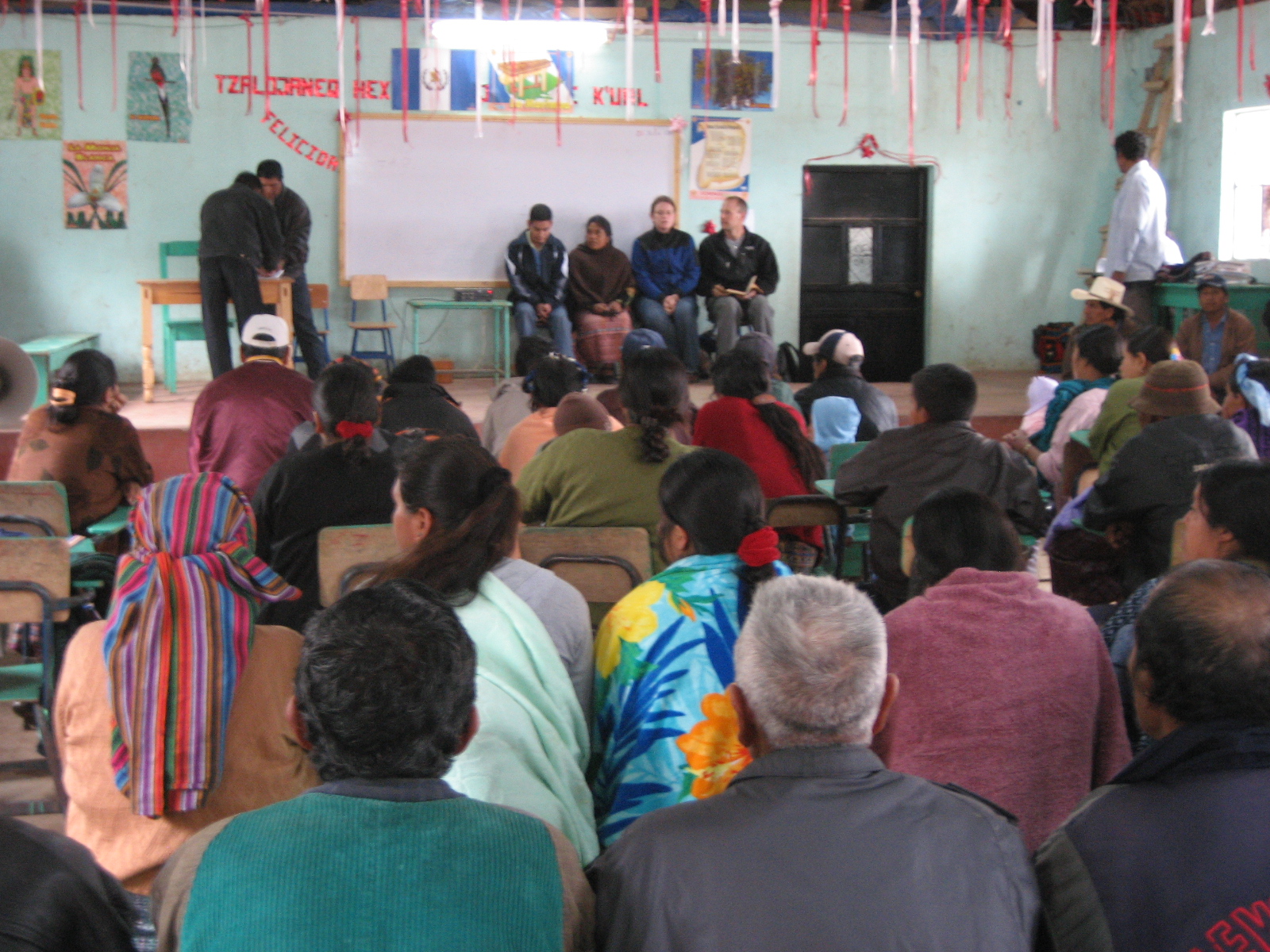 When the tour ended, they took us to the community hall next door. When we entered, I was shocked to see about 100 faces looking at us: the entire town had turned out to meet us. Emily, the Doctor, the tech and I were given the 4 seats on the stage. The mayor fired up the PA system, and started explaining about us in Q’anjob’al, the local Mayan dialect. Luckily, the nurse next to us translated into Spanish so we could follow along. Over the next hour, various speakers discussed us, taking the occasional question or comment. After the Mayor, we heard the local health minister, the municipal development guy, and a mysterious man with no title who was simply explained as “a respected community leader”. He talked the longest, and seemed to be the key to the whole thing. There was a lot of overlap between the speeches, but the main points were thus (translated from Q’anjob’al to Spanish to English):
When the tour ended, they took us to the community hall next door. When we entered, I was shocked to see about 100 faces looking at us: the entire town had turned out to meet us. Emily, the Doctor, the tech and I were given the 4 seats on the stage. The mayor fired up the PA system, and started explaining about us in Q’anjob’al, the local Mayan dialect. Luckily, the nurse next to us translated into Spanish so we could follow along. Over the next hour, various speakers discussed us, taking the occasional question or comment. After the Mayor, we heard the local health minister, the municipal development guy, and a mysterious man with no title who was simply explained as “a respected community leader”. He talked the longest, and seemed to be the key to the whole thing. There was a lot of overlap between the speeches, but the main points were thus (translated from Q’anjob’al to Spanish to English):
- These Americans are here to help train us about disease prevention and health. They aren’t doctors. If things go well in the first year, then they will help us build concrete floors, stoves, latrines,
etc. the second year. They have given up a lot to be here, so we should treat them well and try to make them feel welcome. - They aren’t here to steal our babies. Only dumb campesinos believe those rumors, and we must do our best to dismiss this myth with our neighboring communities as well. Oh, and they have nothing to do with that kid that disappeared 2 months ago, either.
- This is a great opportunity for our community, so try to take advantage of their presence. We might get more volunteers in the future if we prove we’re worth the effort.
- They aren’t here to change the way we bathe (this drew a lot of relieved chuckles, i think because they use the traditional sweatbath here)
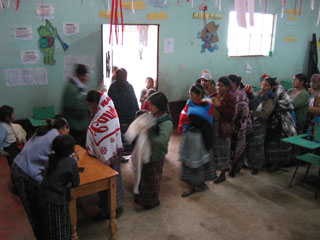 They then discussed our need for a place to live. A few elders came up later and said that they’d talk it up with families in the village before we return on the 20th, and asked what our needs were. To better blend with the community, we only asked for a room with a bed, a writing desk, and a locking door (Peace Corps reg, not because we have a mistrust of the community). Shower and electricity would be nice, but aren’t mandatory. In all, it struck me like these folks weren’t looking for a handout, and are really invested in ooperative development.
They then discussed our need for a place to live. A few elders came up later and said that they’d talk it up with families in the village before we return on the 20th, and asked what our needs were. To better blend with the community, we only asked for a room with a bed, a writing desk, and a locking door (Peace Corps reg, not because we have a mistrust of the community). Shower and electricity would be nice, but aren’t mandatory. In all, it struck me like these folks weren’t looking for a handout, and are really invested in ooperative development.
Near the end of the meeting, we were given a chance to speak. Some of them speak Spanish, and ALL wanted to hear us, so i started out with tra him ba ayesh eymasanik, which in Q’anjob’al is a sort of “hello everyone in the room” greeting we learned the day before. It amused them greatly. We then explained (in Spanish) that we are glad to be here, and are grateful for the invitation and are going to study Q’anjob’al to better speak with them during our work the next 2 years. Then, at the end of the meeting, something odd happened. The town secretary put the ledger on a desk, and the entire village lined up to sign the minutes, indicating their approval and support of our presence here. It was a pretty serious, heavy moment.
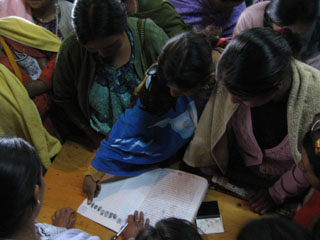 We then adjourned to the health center, where the women had prepared us a nice meal of chicken stew- us, the Doctor, the tech, and the village elders. At the end of the meal, the ledger was brought to us so we could sign it too. After signing, i looked back and saw that about three-quarters of the the signees were thumb prints with printed witness names above: signatures made by the illiterate. I guess that shows what we’ll be dealing with in our seminars; visual aides will be pictures only!
We then adjourned to the health center, where the women had prepared us a nice meal of chicken stew- us, the Doctor, the tech, and the village elders. At the end of the meal, the ledger was brought to us so we could sign it too. After signing, i looked back and saw that about three-quarters of the the signees were thumb prints with printed witness names above: signatures made by the illiterate. I guess that shows what we’ll be dealing with in our seminars; visual aides will be pictures only!
After that, we returned to Santa Eulalia. Basically, we are changing our mission plan. We discussed all of this with the Peace Corps coordinator after we returned to HQ, and he agrees that Temux is really where we need to be, due to their interest, enthusiasm, and desperate need. It will be even more challenging than Santa Eulaia, and there is a lot of work to be done. We still don’t know where we will be living and need to learn Q’anjob’al, but that will all work itself out in time.
Doña Suzanna’s Stove
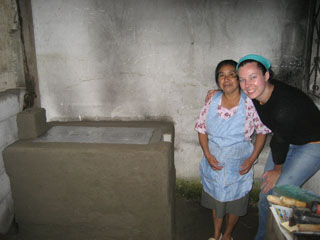 I’ve mentioned before how word gets around hrough the high-bandwidth grapevine around here. A few weeks ago, Doña Suzana (the housemother of Emily Alta) found out that we build high efficiency woodburning stoves for the poor in the country. She began hinting to us that she’d REALLY like one. We were game, but we have no funding right now and she isn’t poor, so Emily told her that we would make her one if she got all the supplies. Well, she called our bluff and bought a bunch of concrete block, chimney pipe, sand, cement, and a Q450 plancha. Thus, we donned the rubber boots and work gloves and busted out this rather slick stove for her. Notice how SMALL she is compared to Emily the Gringa next to her…
I’ve mentioned before how word gets around hrough the high-bandwidth grapevine around here. A few weeks ago, Doña Suzana (the housemother of Emily Alta) found out that we build high efficiency woodburning stoves for the poor in the country. She began hinting to us that she’d REALLY like one. We were game, but we have no funding right now and she isn’t poor, so Emily told her that we would make her one if she got all the supplies. Well, she called our bluff and bought a bunch of concrete block, chimney pipe, sand, cement, and a Q450 plancha. Thus, we donned the rubber boots and work gloves and busted out this rather slick stove for her. Notice how SMALL she is compared to Emily the Gringa next to her…
Garbage
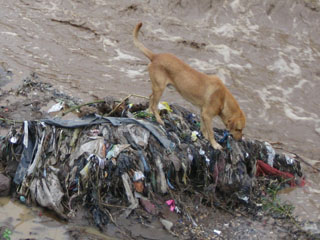 My dad and Ralph (an outdoorsman and good friend of mine) asked me how the fishing was here in Guatemala. I haven’t had time to look into it, but I have my suspicions that it’s not very good. The rivers here run brown and smell like open toilets, on GOOD days. On bad days, they are black and I can’t begin to describe the smell. The chuchos (mangy street dogs) sift through the flotsam looking for snacks. I doubt that anything remotely fishlike could possibly survive in there. Sadly, some locals told me that the river pictured here was clear and clean just 15 years ago. The problem is that Guatemalans have been throwing
My dad and Ralph (an outdoorsman and good friend of mine) asked me how the fishing was here in Guatemala. I haven’t had time to look into it, but I have my suspicions that it’s not very good. The rivers here run brown and smell like open toilets, on GOOD days. On bad days, they are black and I can’t begin to describe the smell. The chuchos (mangy street dogs) sift through the flotsam looking for snacks. I doubt that anything remotely fishlike could possibly survive in there. Sadly, some locals told me that the river pictured here was clear and clean just 15 years ago. The problem is that Guatemalans have been throwing
their trash around for a thousand years; but back then, all the trash was biodegradable: banana leaf tamale wrappers, avocado skins, etc. With the import of fast-food containers and mylar potato chip bags, their habits haven’t changed but their discarded items are now permanent. I see people throw soda cups and diapers from bus windows all the time, and it all adds up. It’s such a monumental task to make them see things differently, and it will take years and a lot of PR to turn it around.
I hope to see better rivers when we move to our site in the mountains later this month- since we will be upstream from most of the pollution sources. I will keep you posted, and let you know if I need any fishing tackle shipped here! As a side note, when we met with the American ambassador to Guatemala a few weeks ago, I asked him about the fishing here, and he said it was pretty good. This baffled me, then i realized he meant deep-sea fishing. Sigh. Not my kindof thing.
Intellectual property
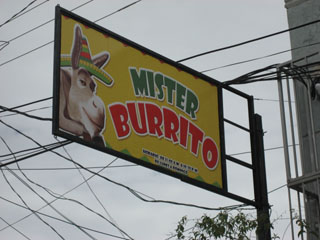 Being an architect, the concept of “intellectual property” is important to me. I make my living off of selling ideas. My friends in the writing and movie industries have similar concerns, and when someone takes someone else’s idea and sells it, that (to me) is a form of stealing. Here in Guatemala, that is COMPLETELY outside of their paradigm. I think this is in part because of general lawlessness here, but more because the culture is very communal- if you have some extra food, and someone else in your group is hungry, you just give it to them. This seems like basic human “good behavior” in small groups, but it extends to town and entire national cultures here. So that leads me to discuss bootleg videos and music. When you go to the market here, you can’t walk 50 feet without passing a stall whose sole business is selling CDs and DVDs for a dollar or two apiece, none of which are legitimate. And it’s everywhere. Last week, i watched Kung Fu Panda with the kids in the house on their DVD player. Mind you, this JUST came out in theaters. And, obviously, it was a bootleg; if the newness didn’t give it away, then the sound of the audience laughing over the soundtrack and the occasional silhouette head moving at the bottom of the screen certainly would. While I was walking in Huehuetenango, i saw this sign for a burrito place and actually laughed out loud. Then I shouted “Donkey!!” in a bad Mike Myers accent, and thought of Mel Cordan, my friend who worked on the Shreks.
Being an architect, the concept of “intellectual property” is important to me. I make my living off of selling ideas. My friends in the writing and movie industries have similar concerns, and when someone takes someone else’s idea and sells it, that (to me) is a form of stealing. Here in Guatemala, that is COMPLETELY outside of their paradigm. I think this is in part because of general lawlessness here, but more because the culture is very communal- if you have some extra food, and someone else in your group is hungry, you just give it to them. This seems like basic human “good behavior” in small groups, but it extends to town and entire national cultures here. So that leads me to discuss bootleg videos and music. When you go to the market here, you can’t walk 50 feet without passing a stall whose sole business is selling CDs and DVDs for a dollar or two apiece, none of which are legitimate. And it’s everywhere. Last week, i watched Kung Fu Panda with the kids in the house on their DVD player. Mind you, this JUST came out in theaters. And, obviously, it was a bootleg; if the newness didn’t give it away, then the sound of the audience laughing over the soundtrack and the occasional silhouette head moving at the bottom of the screen certainly would. While I was walking in Huehuetenango, i saw this sign for a burrito place and actually laughed out loud. Then I shouted “Donkey!!” in a bad Mike Myers accent, and thought of Mel Cordan, my friend who worked on the Shreks.
Goodbye party
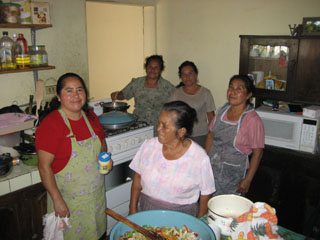 In our time here, our host families have become pretty attached to us, and us to them. We’re the first Peace Corps volunteers this town has ever had, and we’ve all been through some pretty intense times together. Last week, the four mothers got together without our knowledge and planned a surprise going away party for us. These cute little old ladies cooked a pretty elaborate meal of baked stuffed chicken, cucumber stew, banana molé, and homemade lemonade. It was very touching and emotional, and they are really very sad to see us go: i guess they’ve become accustomed to our silly questions, innocent need to be taken care of, honesty, and kind-spiritedness. For our part, we are going to miss them as well, and they all did a great job of taking care of us, both emotionally and physically. In that sense, we all got pretty lucky: volunteers in other towns occasionally had troubles with their families (for instance, one person got spit on by an angry kid in the household, and another has to constantly fight with his host mom to get enough to eat, and another has a drunk dad that rifled her underwear drawer). The only complaint we could have is that our families are TOO good: the occasional scolding for being out too late (thieves) or for not finishing all the food on the plate.
In our time here, our host families have become pretty attached to us, and us to them. We’re the first Peace Corps volunteers this town has ever had, and we’ve all been through some pretty intense times together. Last week, the four mothers got together without our knowledge and planned a surprise going away party for us. These cute little old ladies cooked a pretty elaborate meal of baked stuffed chicken, cucumber stew, banana molé, and homemade lemonade. It was very touching and emotional, and they are really very sad to see us go: i guess they’ve become accustomed to our silly questions, innocent need to be taken care of, honesty, and kind-spiritedness. For our part, we are going to miss them as well, and they all did a great job of taking care of us, both emotionally and physically. In that sense, we all got pretty lucky: volunteers in other towns occasionally had troubles with their families (for instance, one person got spit on by an angry kid in the household, and another has to constantly fight with his host mom to get enough to eat, and another has a drunk dad that rifled her underwear drawer). The only complaint we could have is that our families are TOO good: the occasional scolding for being out too late (thieves) or for not finishing all the food on the plate.
So, that’s about it for this post. We are swearing in as official Peace Corps Volunteers (as opposed to Peace Corps Trainees) on Friday, then we’re off to our site for permanent. More on that in the next post.
-jim/ fletch/ jaime